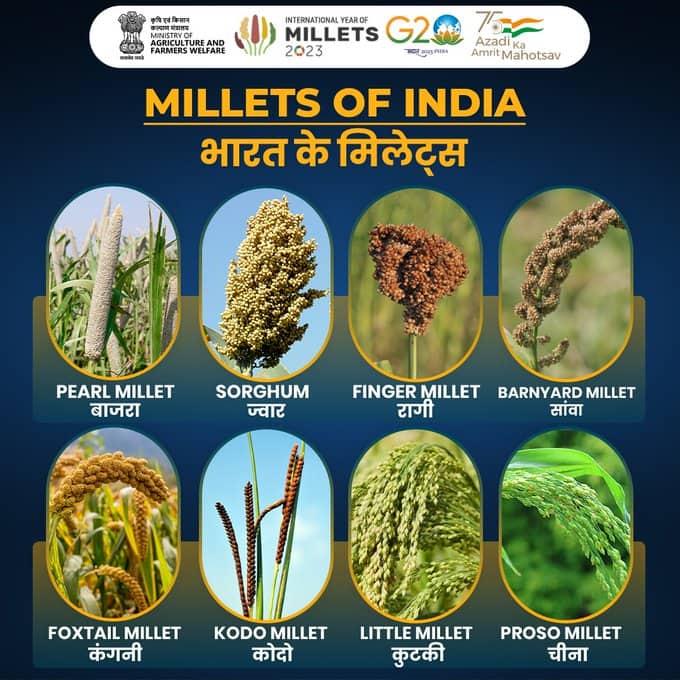



Note to readers: The Whole Truth is a fortnightly exploration of wellness trends, to separate the healthful from the unhelpful.
The ad that the UN’s Food and Agricultural Organisation has released coinciding with the announcement that 2023 will be marked as the International Year of Millets, could well be an offshoot of the India Shining campaigns we got used to seeing on every channel and hoarding back in 2013-14. A small, lush green millet sapling, wriggling out of arid soil talks via a heavily-accented narrator:
“I may be small, but I am strong
I grow where others cannot
I thrive in dry and harsh conditions…”
And it goes on about the wondrous benefits of millets, a grain associated with ancient civilizations, the sapling finally urging us to bring it back to our dinner tables.
A lot of Indians already eat millets. The Ragi Mudde, for instance. In Karnataka and the Rayalseema region of Andhra Pradesh, this ball made with cooked millets and flavoured with local spices, is common among rural folk. It’s known for taste, nutritional value and long satiety.
The health-conscious urban Indian, who, according to most consumer research coming out of the food retail, skincare and healthcare industries these days is a rapidly swelling demographic, is choosing ragi dosa over the normal white rice-and-urad dal dosa and gluten-free jowar over glutenous wheat as meal staples.
For a few years now, retail companies have been selling ragi cookies and ragi chips. The trend is only increasing, with our government’s spotlight on millet as an indigenous grain beneficial both to farmers and for the health of Indians. The spotlight, fuelled by events like the Millets India 2022, which concluded at Greater Noida last November, and also the Union Budget, will likely only get more expansive in the coming months. All these initiatives are market-centric, with a lot of promise for farmers as well as consumers.
Millets are truly a wonder grain. I say not as a nutrition expert but as someone who has consulted with nutritionists and interviewed nutritionists such as Rujuta Diwekar, Anju Venkat and Luke Coutinho over the past five years following a health crisis which forced me to stop in my tracks and overhaul my diet and lifestyle. Many nutritionists will tell you switching to a grain with a low glycemic index, without gluten, and plenty of minerals and vitamins like millet from, say, polished rice or commercially-packaged wheat, and sustaining this choice for a considerable period of time can be transformative for our bodies.
Low glycemic index foods release lower amounts of sugar in the blood.
But is nutrition that simple? And can eating be so clinically rejigged just for health benefits?
Unless the millets we bring back to our dinner tables have the bran intact (millet bran is packed with minerals and vitamins, more than the bran of some other grains), we don’t optimise its benefit to our body’s systems.
Processed, simplified and packaged millet is not magic — some nutritionists say it could be as nutrient-dense as regular packaged grain. The packaging of Ragi Cookies by a well-known brand promises “complex carbohydrates” and “high dietary fibre”, but with preservatives, sugar and the other boosters that go with packaged products, its nutritional value isn’t at a level much higher than a packet of Marie Gold.
Eating and food habits are a matter of cultural and generational conditioning. When I was at the lowest ebb of my health in 2017, a plate of Assamese fish curry with Joha rice, a grain from Assam whose fragrance took me straight back to feasts from my childhood, was a luxury I chose to afford. The food I cook and love, as opposed to junk, packaged food, has, I believe, more healing properties than food that I eat just because it has health benefits.
 Millets of India (Image source: Twitter/IYM2023)
Millets of India (Image source: Twitter/IYM2023)
The best nutritionists customise diet charts according to habit and conditioning. People who eat rice can be healthy, people who eat millets can be healthy, people who eat quinoa or regular wheat can be healthy too. Health is a whole spectrum — and being authentic to ourselves, and emotions associated with our desires, is as important as the next nutrient-dense grain we next move on to.
So for the millet-fuelled health revolution to work, it can’t be the only grain we eat. Food diversity and balance are key to both health and agricultural abundance for our farmers.
As Dwijendranath Guru, a researcher, consultant, activist for sustainable food systems who runs the DHAN Foundations, said, “The spotlight on millet is a necessary thing, but certainly not sufficient. Today, millet cultivators work on marginal lands with low fertility. It is often a farmer’s last choice to grow millets but because it can grow in diverse conditions, they choose it over paddy, the much more lucrative crop. Mono-cropping is never an answer to either sustainability for farmers or for our health. So for millet to transform the food and agriculture landscape in India, we will need to have policies in place for food systems that make the farmer secure. And which can sustain unbruised grains — by which I mean grains with their brans intact.”
So the bran is the nutrient bullet, the lit ingredient. Not just millet.
Discover the latest Business News, Sensex, and Nifty updates. Obtain Personal Finance insights, tax queries, and expert opinions on Moneycontrol or download the Moneycontrol App to stay updated!
Find the best of Al News in one place, specially curated for you every weekend.
Stay on top of the latest tech trends and biggest startup news.